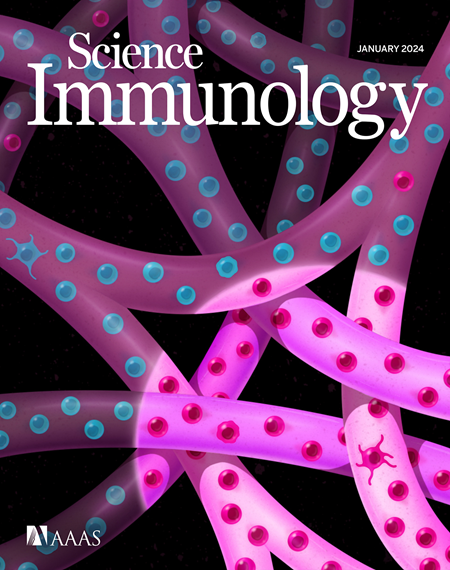Up-regulated PLA2G10 in cancer impairs T cell infiltration to dampen immunity
IF 17.6
1区 医学
Q1 IMMUNOLOGY
引用次数: 0
Abstract
T cells are often absent from human cancer tissues during both spontaneously induced immunity and therapeutic immunotherapy, even in the presence of a functional T cell–recruiting chemokine system, suggesting the existence of T cell exclusion mechanisms that impair infiltration. Using a genome-wide in vitro screening platform, we identified a role for phospholipase A2 group 10 (PLA2G10) protein in T cell exclusion. PLA2G10 up-regulation is widespread in human cancers and is associated with poor T cell infiltration in tumor tissues. PLA2G10 overexpression in immunogenic mouse tumors excluded T cells from infiltration, resulting in resistance to anti–PD-1 immunotherapy. PLA2G10 can hydrolyze phospholipids into small lipid metabolites, thus inhibiting chemokine-mediated T cell mobility. Ablation of PLA2G10’s enzymatic activity enhanced T cell infiltration and sensitized PLA2G10-overexpressing tumors to immunotherapies. Our study implicates a role for PLA2G10 in T cell exclusion from tumors and suggests a potential target for cancer immunotherapy.
癌症中上调的 PLA2G10 会影响 T 细胞浸润,从而抑制免疫力
在自发诱导免疫和治疗性免疫疗法过程中,即使存在功能性 T 细胞募集趋化因子系统,人类癌症组织中也经常缺乏 T 细胞,这表明存在影响浸润的 T 细胞排斥机制。利用全基因组体外筛选平台,我们确定了磷脂酶 A2 组 10(PLA2G10)蛋白在 T 细胞排斥中的作用。PLA2G10 在人类癌症中广泛上调,与肿瘤组织中 T 细胞浸润不良有关。PLA2G10在免疫原性小鼠肿瘤中的过表达会排斥T细胞浸润,从而导致抗PD-1免疫疗法的抗药性。PLA2G10 可将磷脂水解成小的脂质代谢物,从而抑制趋化因子介导的 T 细胞移动。消减PLA2G10的酶活性可增强T细胞浸润,并使PLA2G10过表达的肿瘤对免疫疗法敏感。我们的研究揭示了 PLA2G10 在肿瘤排斥 T 细胞中的作用,并为癌症免疫疗法提供了一个潜在靶点。
本文章由计算机程序翻译,如有差异,请以英文原文为准。
求助全文
约1分钟内获得全文
求助全文
来源期刊

Science Immunology
Immunology and Microbiology-Immunology
CiteScore
32.90
自引率
2.00%
发文量
183
期刊介绍:
Science Immunology is a peer-reviewed journal that publishes original research articles in the field of immunology. The journal encourages the submission of research findings from all areas of immunology, including studies on innate and adaptive immunity, immune cell development and differentiation, immunogenomics, systems immunology, structural immunology, antigen presentation, immunometabolism, and mucosal immunology. Additionally, the journal covers research on immune contributions to health and disease, such as host defense, inflammation, cancer immunology, autoimmunity, allergy, transplantation, and immunodeficiency. Science Immunology maintains the same high-quality standard as other journals in the Science family and aims to facilitate understanding of the immune system by showcasing innovative advances in immunology research from all organisms and model systems, including humans.
 求助内容:
求助内容: 应助结果提醒方式:
应助结果提醒方式:


